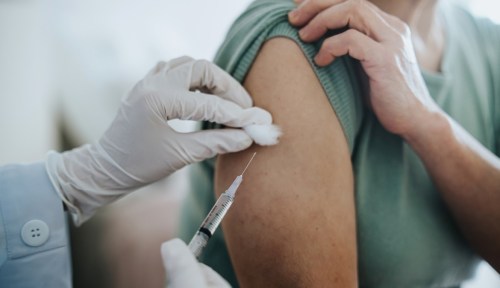Buh-bye, Pap smears: A less invasive test can make your gyno visits *way* more comfortable
New research says testing for human papillomavirus—AKA HPV—is a viable Pap smear alternative. The HPV test is found to be more accurate in detecting cervical cancer than a Pap smear is for women older than 30. Here's what to know.

On a scale of 1 to 10, how much do you hate visiting the gynecologist? (If you answered “12,” same.) The experience typically isn’t the most pleasant—even if you have an amazing doc—for one very specific reason: the notoriously uncomfortable Pap smear. So, you might want to take a seat for this news (but you can keep your feet out of the stirrups): One recent study found that the human papillomavirus (HPV) test is a less painful and more precise alternative for women age 30 and older.
The study, published in JAMA, included more than 19,000 women aged 25 to 65 who were separated into two groups: intervention or control. The intervention group received HPV testing, and those who were negative returned four years later for HPV testing and a Pap smear. The control group received a Pap smear, and those who were negative returned for another one after two years. Those who were again negative returned after another two years to receive HPV testing and a Pap smear.
The results showed that HPV testing was more accurate in detecting harmful cells—which makes sense, considering that 99.7 percent of all cervical cancers are associated with HPV, according to the study. This is particularly impressive when you consider that HPV testing was only repeated after four years, while it’s recommended that women get Pap smears every three years (and in the study, HPV tests were still more accurate than Pap smears taken every two years). Additionally, the HPV test is not nearly as painful or uncomfortable for women to undergo as Pap smears are; a doctor simply swabs samples of vaginal and cervical secretions to test, without the use of a speculum.
“What our study shows is that by using HPV testing, we detect precancerous lesions earlier. If women have a negative HPV test, they are significantly less likely to have a precancerous lesion four years later, meaning we can extend screening time.” —Dr. Gina Ogilvie
“What our study shows is that by using HPV testing, we detect precancerous lesions earlier. If women have a negative HPV test, they are significantly less likely to have a precancerous lesion four years later, meaning we can extend screening time,” lead study author Gina Ogilvie, MD, PhD, told NPR.
With this new information, what are the recommended screening times? According to the just-released guidelines from the US Preventive Services Task Force that were published in the journal JAMA, women ages 30 to 65 now have the choice to either get a Pap smear every three years, an HPV test every five years, or both every five years. For those ages 21 to 29, the previous guidelines remain the same. Getting a Pap smear every three years is the only trustworthy method because nearly all women will contract HPV (and see it go away on its own), according to Kathleen Schmeler, MD, associate professor at the University of Texas MD Anderson Cancer Center. “If you tested everyone for HPV in their twenties, they are almost all going to be positive, but there’s going to be all of this intervention that’s not needed,” she says. But the guidelines could greatly benefit those who are 30 and up, where spotting the virus could mean medical intervention is needed.
Despite this uplifting news, researchers say co-testing, or doing both HPV testing and Pap smears, is still a good idea. So no matter what you choose, be sure to talk to your doctor about the best course of action for staying healthy.
Originally published July 6, 2018; updated August 22, 2018.
Here are five things your OB-GYN really wishes you’d talk about. Or, check out some advice from sex experts about getting it on.










